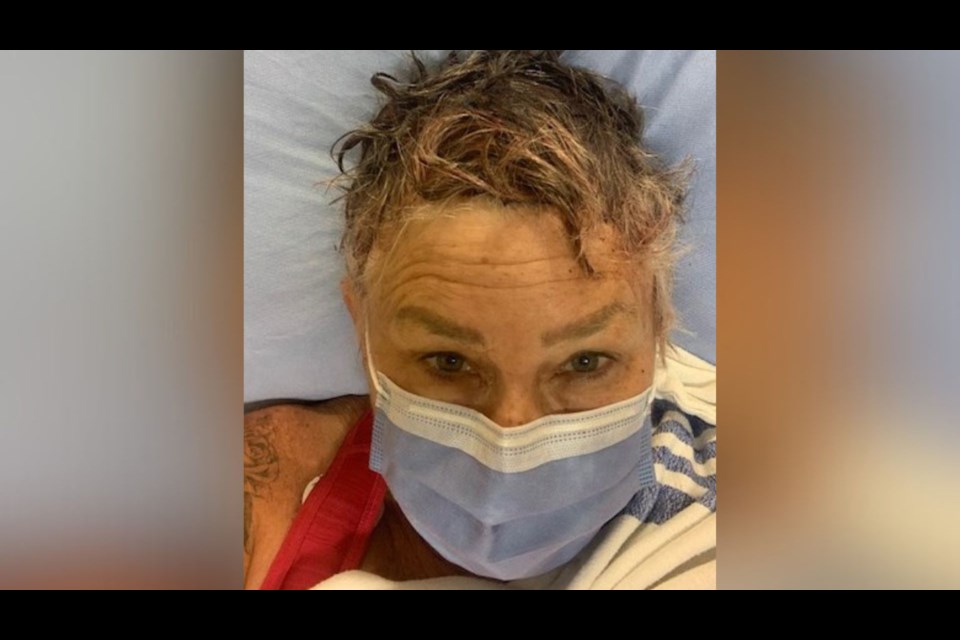When Christine Corkan set out with a friend to hike up the , she couldn't have guessed that she would end the day in hospital.
Nor could the Britannia Beach resident have predicted that two years later, she would still be physically and mentally impacted by the injury she sustained that day.
The hike was fine, "great" even, the then 50-something active local says.
"I was going up chains and ropes; we had a little snack up there and met people," Corkan recalled.
But after the hike, in the afternoon of Aug. 10, 2022, as she was making her way to her truck on a paved path to the Shannon Falls Park parking lot, she was suddenly hit on the head by a piece of tree top that fell from about nine metres (30 feet) above.
She said there were a lot of people around, given that it was midday on a Sunday in August.
Her friend, who confirmed the story with The С����Ƶ, is a retired nurse. She helped Corkan in the immediate aftermath, including stemming the bleeding and calling 911 for an ambulance.
С����Ƶ Emergency Health Services confirmed it received a call about this at 2:17 p.m.
The friend was a bit nervous about how long it was taking the ambulance to come, so she flagged down a pair of British rock-climbing brothers who rushed Corkan to Squamish Hospital in their rental car.
She was then transferred to Lions Gate Hospital in North Vancouver.
She received 16 staples to her head and suffered a concussion and a compression fracture in her spine.
"Luckily, I have extended medical, but have had many treatments with out-of-pocket expenses," she said.
She was working part-time at the time, so she only missed a few days of work.
"But what if I was a provider for my family? What if I didn’t have coverage for all?"
Physically, her balance has been off since the incident, she said, and she believes this caused two other injuries when she tried to resume her normally active lifestyle.
She suffered a fractured sternum from a fall off her bike two months later and a broken ankle hiking when she lost her balance suddenly that autumn.
"The worst is what feels like PTSD. I’m scared to do all of the things that I loved to do," she said, noting she really misses skiing, which she had done since she was five years old.
"I tried one time last year, and I couldn’t do it. I was so scared. I have lost my old, adventurous self and there is nothing that I can do about it," she said, adding she is generally more fearful and on high alert.
"I've turned into the safety officer,” she joked.
Corkan is telling her story as the two-year anniversary of the incident approaches to raise awareness that, though they are provincial parks, things can still happen in nature.
"You don't have to be doing an extreme anything to be hurt, you know? But what can you do about it? I don't know. We have to keep living," she said.
"This can happen to anybody."
С����Ƶ Parks: 'Will follow up'
Corkan’s friend said that she contacted С����Ƶ Parks twice about the incident but didn't hear back.
A spokesperson for the Ministry of Environment and Climate Change Strategy, which is responsible for С����Ƶ Parks, said the ministry did not have a record of this incident in particular and encouraged Corkan to reach out personally so they could learn more and make any suitable improvements.
Beyond contacting medical personnel, people can report safety incidents in provincial parks to staff and park operators, and at any time to [email protected], and С����Ƶ Parks staff will follow up.
According to the ministry, about 573,000 people visit Shannon Falls each year, and that number is rising annually.
Regarding safety in provincial parks generally, the spokesperson noted that thousands of trees are in provincial parks, and thus, the ministry takes "important steps to ensure long-term forest health while keeping visitors safe."
С����Ƶ Parks park operators responsible for managing provincial parks are mandated to conduct hazard tree assessments regularly, according to the spokesperson. These assessments are typically conducted in spring before each provincial park opens.
"Certified assessors search for trees that pose a safety hazard. Certified assessors are trained to identify trees that may appear healthy but are at risk of falling and causing harm or damage," he said.
"We recognize there can still be risks in the natural environment, including from the effects of wildfires, and will follow up on any safety concerns reported to us."
There are also С����Ƶ Parks signage on kiosks alerting people to risks, and the ministry encourages people to check online for more information about what they can expect before visiting a provincial park, the spokesperson noted.




